The Versatility of Outdoor Concrete Pots in Modern Design
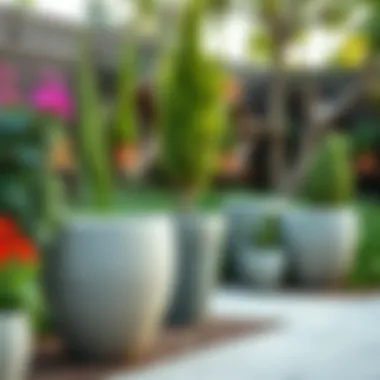
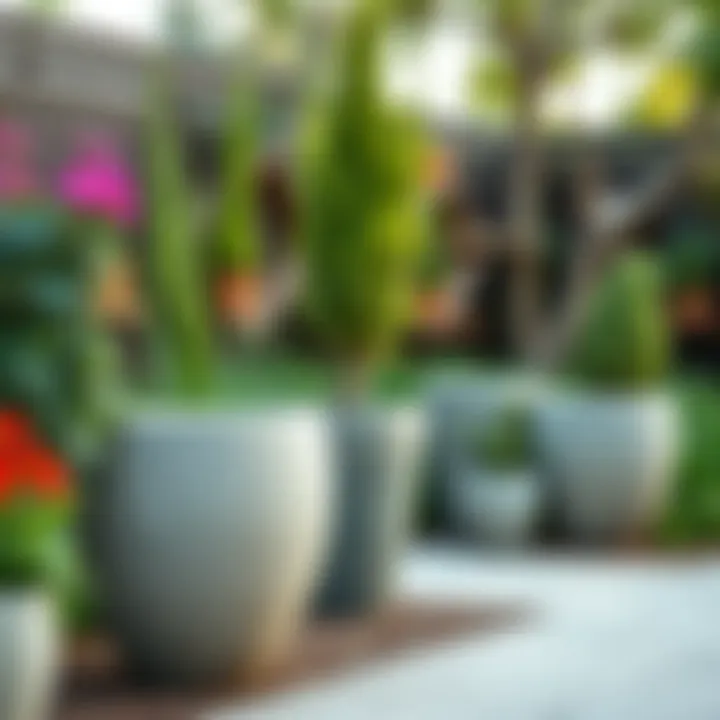
Intro
In today's world of design, outdoor spaces are increasingly important. People are searching for ways to create their own personal oasis right in their backyards. One material that has gained popularity in both landscaping and interior decor is concrete. Among the many concrete products, outdoor concrete pots have become quite versatile, serving numerous functions and enhancing the beauty of any environment.
These pots, with their robust design and aesthetic appeal, can serve various purposes—be it for planting flowers, creating dramatic statements, or even enhancing overall ambiance. They’re not just for plants; they can serve to define areas, act as sculptures, or simply provide a stylish framework for outdoor settings.
In this exploration, we will dive into the many roles outdoor concrete pots play in modern design, looking closely at their characteristics, the range of styles available, and practical tips for making the most out of them in any space.
Prolusion to Outdoor Concrete Pots
Outdoor concrete pots are not only functional but also serve as striking accents in landscaping and architectural designs. Their role transcends mere plant holders; they are integral to crafting the overall aesthetic and ambience of outdoor spaces. By understanding the nuances of these concrete masterpieces, homeowners and designers can unleash their creative potential, marrying usability with style.
The importance of discussing outdoor concrete pots lies in their adaptability. They can complement various design styles—from sleek modernism to rustic charm—making them a favored choice among diverse audiences. Furthermore, their durability and weather resistance structure speak volumes about their suitability for long-term outdoor use.
Concrete pots cater to a wide array of needs. They can serve as statement pieces that draw attention to certain garden features, or as subtle enhancements that blend seamlessly into the surroundings. Knowing how to select and position these pots can elevate ordinary landscapes into something captivating.
Historical Context
Concrete as a material has roots that stretch back over two thousand years. Its versatility and strength quickly caught the attention of ancient civilizations. The Romans, for example, utilized concrete in various structures, paving the way for the modern construction methods we admire today. This proves that concrete is not just a contemporary novelty but an enduring staple in design history.
As landscaping practices evolved, so did the use of concrete. In the 20th century, with the industrial revolution as a backdrop, concrete gained traction in exterior design. Once considered functional and bland, the implementation of texture and form transformed it into an aesthetic choice as well. Now, outdoor concrete pots, once unlikely garden companions, have become symbols of modern landscaping artistry.
The Rise in Popularity
Today, outdoor concrete pots are undeniably trending. Several factors play into their rise, but a few stand out prominently. Firstly, there's the growing emphasis on sustainable and eco-friendly products. Concrete's durability means it doesn't need frequent replacement, aligning with environmentally conscious practices. Homeowners and designers are increasingly attracted to long-lasting materials that won't end up in a landfill yearly.
Moreover, the boom in DIY culture has pushed concrete pots into the spotlight. Thanks to abundant resources online, making bespoke concrete pots has become accessible to many, allowing for personal expression in gardens. There’s something satisfying about crafting a one-of-a-kind pot that reflects one's style.
Also, the versatility of concrete allows for customization—shapes, sizes, and finishes are practically limitless. This adaptability can cater to a range of preferences, from simple to elaborate designs, which keeps these pots relevant across varying architectural styles and trends.
"The adaptability of outdoor concrete pots enables them to fit seamlessly into any landscape design, making them a staple in contemporary gardening."
Material Composition and Properties
Understanding the material composition and properties of outdoor concrete pots is vital in appreciating their role and versatility in modern design. Concrete is not just a base for structures; it’s a canvas for creativity and functionality. This section dives into what makes concrete a prime choice for outdoor applications, addressing its nuances and advantages.
Analyzing Concrete as a Material
Concrete, at its core, is a mixture of cement, water, aggregates, and sometimes additional additives. This combination creates a strong material that can be cast into various shapes and sizes. One of the unique features of concrete is its ability to cure and harden over time, gaining strength. This is a crucial characteristic that sets it apart from other materials in outdoor environments. Unlike wooden or plastic planters that may war with the elements, concrete develops a resilience that many homeowners find enticing. Its dense nature not only reinforces its physical strength but also allows it to showcase a range of finishes, enabling designers and architects to tailor each piece to suit different tastes and settings.
Benefits of Using Concrete for Outdoor Applications
Durability
Durability is perhaps the most notable quality of concrete. It has a remarkable ability to withstand various environmental conditions—be it extreme heat, cold, or even humidity. This resilience can be attributed to the chemical reactions that take place as the concrete cures, enhancing its structural integrity. For outdoor concrete pots, this means they can remain intact and visually appealing for years, even when faced with the sun's relentless rays or winter's icy grip. The longevity of concrete pots makes them a popular and sensible choice for those looking to invest in their garden or patio spaces without the constant fear of replacement.
Weather Resistance
Another prime aspect is weather resistance. Concrete pots are known for their ability to endure rain, snow, and wind with little impact on their form. This is essential for outdoor plants that might, otherwise, be vulnerable to pot failure due to moisture absorption or fungal growth in traditional materials. Concrete also helps maintain a stable root temperature, protecting plants from rapid temperature changes. Homeowners often enjoy the peace of mind knowing their choices can weather the storm—literally and figuratively. The unique feature of this weathering capability ensures that concrete pots won't just last but also maintain their aesthetic quality and structural soundness over time.
Versatility in Form and Finish
Versatility in form and finish gives concrete an edge in design options. Its malleability allows for a variety of shapes—ranging from modern geometric forms to classic rounded pots, making it suitable for any design philosophy. Moreover, the capacity to apply various finishes means that the same base material can take on an array of appearances. From rustic textures to sleek, modern aesthetics, the finishing touches can transform a concrete pot into a stunning focal point or a subtle background piece. This adaptability is particularly attractive to designers and DIYers seeking to express personal style while benefiting from a durable material.
"Concrete's resilience and adaptability are unmatched, making it a cornerstone in modern outdoor design."
Design Options for Outdoor Concrete Pots
Selecting the shape, size, and finish of outdoor concrete pots is not just about aesthetics; it’s about making a statement that resonates with the overall landscape design. The variety of choices available opens up possibilities for both homeowners and designers to play with forms that fit their vision and purpose. Each option contributes differently to the overall feel of outdoor spaces, impacting not just the visual warmth but also the functionality of the pots in natural settings or urban environments.
Shapes and Sizes
Traditional Round
The traditional round pot evokes a sense of classic charm. Its smooth, curved lines offer softness that contrasts with angular surroundings, making it an easy choice for many gardeners. One key characteristic of the traditional round design is its adaptability; it looks at home across various contexts, from rustic gardens to modern balconies.
The unique feature of these pots is their uniform shape, allowing for natural light to hit every angle, essentially illuminating the plants they hold in a subtler way. However, their roundness means they can occupy more space, which might not be ideal for smaller areas.
Using traditional round pots can create a focal point, drawing attention to stunning flowers or unique foliage.
Modern Square
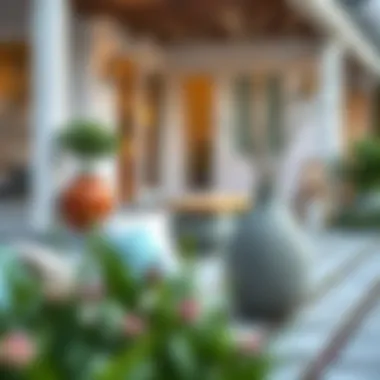
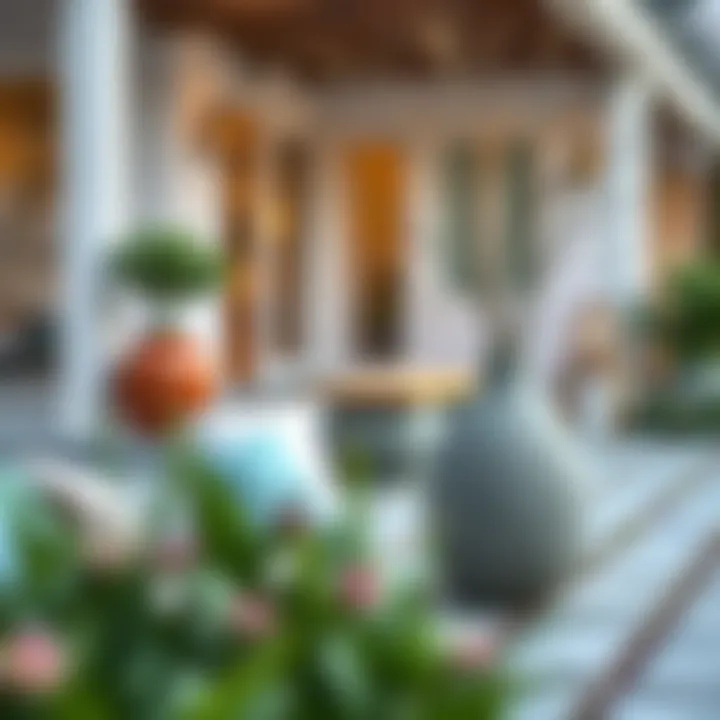
On the flip side, the modern square pot presents a bold statement. This geometric form reflects a sleek, contemporary feel that might resonate with modern architecture or intentional landscaping. The key characteristic of a modern square pot lies in its defined lines and structured appearance, which can provide a striking contrast in soft garden beds and livelier zones.
These pots often integrate seamlessly into outdoor spaces that emphasize minimalism or industrial aesthetics. A unique advantage is their ability to align snugly against walls or in tight spaces without sacrificing style. However, some may find the linear nature to be less inviting compared to the traditional round forms.
Custom Designs
The beauty of custom-designed concrete pots can't be overstated. The specific aspect of these pots is their ability to cater to individual tastes and specific planting needs. From dimensions that perfectly fit particular plants to styles that marry various cultural influences, a custom design can serve significantly in delivering personalized landscapes.
A standout feature here is freedom; you can incorporate unique decorative elements such as engraved patterns or specific colors, transforming an everyday planter into a conversation starter. The main consideration, however, is cost; custom options can often be pricier than standard models.
Finishes and Textures
Polished
Polished concrete pots exude a sleek, refined appearance that can elevate any outdoor space. Their glossy surfaces reflect light beautifully, bringing an added layer of elegance. A primary characteristic is this shiny visage, acting like a mirror that interacts with surrounding elements.
The unique feature of polished pots is their ease in cleaning; dirt and grime easily wash off, maintaining the aesthetic appeal. Nonetheless, their glossy finish may not suit every design style, particularly in more rustic or earthy landscapes.
Textured
In contrast, textured pots bring a tactile experience to outdoor design. Their uneven surfaces introduce depth and character, breaking away from the monotony of polished options. A key characteristic of textured pots is that they can blend into garden styles that promote organic and natural lines.
They tend to hold plant moisture more effectively due to their surface variations. However, maintaining their cleanliness can prove challenging, as dirt can lodge deep into grooves.
Painted Techniques
Painting concrete pots opens further avenues for creativity. With vibrant colors and various techniques, painted pots can rejuvenate a landscape, creating a playful atmosphere. A vital aspect of painted pots is their adaptability to personal flair, enabling homeowners to match them with outdoor decor or seasonal themes.
The unique feature here is, of course, vison; bright colors can attract attention or mark certain zones in gardens. Care is needed, though; paint can wear with time, demanding reapplication, which may be a downside for some.
Integrating Concrete Pots into Landscapes
Focal Points in Gardens
Using concrete pots as focal points within gardens is a design strategy that can dramatically influence the overall layout. By placing striking pots amid other plants, they draw the eye, creating a visual hierarchy. The key characteristic of this approach is how it can enhance the perceived structure of the garden, inviting exploration and admiration from viewers.
Their sheer presence can lend balance to more chaotic plant arrangements, guiding the visitor’s attention purposefully through the space. One downside might be the need for careful positioning to cope with changing light conditions that affect plant growth inside the pots.
Groupings for Impact
Groupings of concrete pots can easily create dramatic visual impacts. This approach highlights the beauty of repetition and variation by arranging multiple pots with differing heights or textures in one area. The essential advantage here is that it can make a space seem fuller and more dynamic even in small gardens or patios.
This method allows for versatile plant combinations, but it requires thoughtful planning to avoid creating visual clutter. Too many pots placed without intent can easily dilute the impact to be achieved.
Functional Aspects of Outdoor Concrete Pots
Understanding the functional aspects of outdoor concrete pots is vital for anyone seeking to blend aesthetics with practicality in their designs. These pots do more than just hold plants; they play a crucial role in enhancing the viability of landscaping projects. As we peel back the layers of their versatility, we uncover the significant benefits offered by their applications in planting and weight considerations, which balance beauty with function.
Applications in Planting
Selecting the Right Plants
When it comes to outdoor concrete pots, selecting the right plants is an element that can't be overlooked. The suitability of plants not only depends on aesthetic appeal, but also on the specific conditions of growth they require. Certain plants thrive in the microclimates created by concrete materials. This characteristic makes concrete pots a favorable choice for more resilient plant varieties, such as succulents and drought-resistant flowers, which require less frequent watering.
A unique feature of selecting the right plants is the capacity of concrete pots to adapt to different moisture levels. This characteristic can lead to successful plant growth and even longevity, making it beneficial for homeowners who want low-maintenance options. However, one might consider the disadvantages as well, mainly due to the heavy weight of certain plants like large ferns, which may not be well supported by smaller pots or require careful consideration regarding mobility.
Drainage Considerations
Another key aspect is drainage considerations. Proper drainage is essential to prevent over-saturation and root rot, common issues in outdoor settings. Outdoor concrete pots typically incorporate drainage holes, which are critical because they allow excess water to escape. This design feature is not merely a random perk; it ensures that plants maintain optimal hydration levels without drowning.
This characteristic contributes greatly to the overall success of planting. The adaptability that concrete pots offer, such as being able to hold soil while allowing for drainage, is particularly advantageous for gardeners looking to create thriving landscapes. The distinctive feature of integrated drainage systems means that maintaining healthy plants becomes less of a chore.
However, it's important to note that certain ornamental designs may overlook drainage, leading to potential pitfalls. This can be a downside if one fails to select pots with adequate drainage features, resulting in less-than-ideal conditions for plant growth.
Capacity and Weight Considerations
Capacity and weight considerations stand out as another fundamental functional aspect of outdoor concrete pots. The weight of the pots has its pros and cons; on one hand, heavier pots resist wind and storms better, thus maintaining their positioning in even the worst weather. This stability is particularly vital for larger, top-heavy plants which might tip over in a light breeze if planted in lighter containers.
However, the weight of concrete can be a double-edged sword. It can complicate transportation and rearrangements in the garden or patio. Homeowners and gardeners often have to think twice before shifting these pots. An understanding of the balance between the pot's capacity and its weight is crucial, ensuring that plants remain undisturbed during seasonal shifts or renovations in landscaping.
In summary, a clear grasp of the functional aspects of outdoor concrete pots can guide homeowners, designers, and even retail professionals towards better choices, tailing aesthetics with purpose for effective outdoor utilization.
Maintenance and Care for Outdoor Concrete Pots
Making the right call on maintaining and caring for outdoor concrete pots can significantly impact their lifespan and overall appearance. In an age where aesthetics meet functionality, understanding how to properly care for these versatile containers spells the difference between a thriving garden spectacle and a dreary outdoor setup. Homeowners, designers, and DIY enthusiasts alike should pay special attention to these pots, as they not only serve as stylish additions but also as practical vessels for nurturing various plant life.
Taking a few precautionary steps can save headaches later on. Just as you'd give your car an oil change for longevity, treat your concrete pots to a bit of TLC. This section dives into some of the essential cleaning and care practices, plus tips to fend off the lurking damage from Mother Nature.
Cleaning Techniques
Cleaning your concrete pots may sound as straightforward as it gets, but it’s essential to do it right. Over time, dirt, algae and even mineral deposits can settle on their surfaces, dulling their once vibrant finish. Regularly cleaning these pots not only keeps them looking their best but also prevents buildup that can affect their integrity.
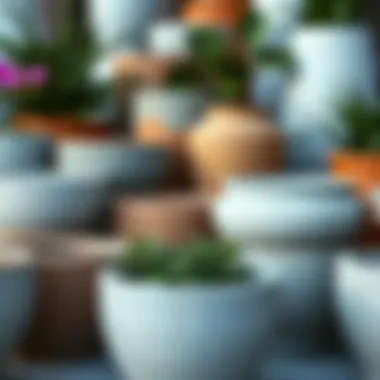
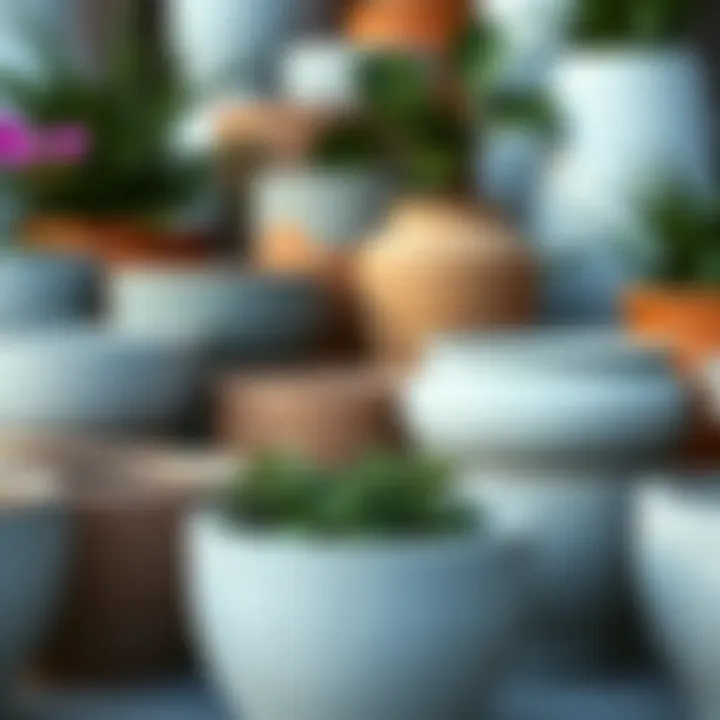
- Start off with a soft brush or sponge to scrub away loose dirt.
- Occasionally, it might be necessary to use a mild soap solution mixed with water for a deeper clean. Avoid harsh chemicals as they can be more damaging than effective.
- Rinse thoroughly and ensure not to leave any soap residue behind which could lead to unsightly marks or even harm your plants over time.
Keeping your concrete pots squeaky clean not only pleases the eye but also sets the stage for healthier plants. Healthy pots, after all, lead to thriving greenery!
Preventing Damage from Weather
Outdoor concrete pots endure a lot; it's almost like they wear a badge of honor. They stand strong through hailstorms, scorching sun, and everything in between. Nevertheless, without some forethought on weather-proofing, they can succumb to damaging elements. This is where preventive measures become crucial.
Winterization Techniques
Winterization may seem a hefty word for some, yet in essence, it means preparing your concrete pots for the colder months. Cold snaps can cause water to freeze within the concrete, leading to cracking when those temps dip too low. Here is why winterization matters:
- Crack Prevention: Protecting the integrity of the pot helps it remain functional over time. Choosing to winterize is a kind of financial prudence; after all, replacing cracked pots can eat into your budget.
- Insulation Options: Consider using mulch or natural fibers to insulate around the pot, which can bring an added layer of protection. Some even suggest wrapping pots in burlap to keep the chill at bay.
This approach doesn't only help in retaining appearance but also in retaining function for many seasons ahead.
Avoiding Moisture Accumulation
Moisture management is yet another vital element to maintain your outdoor concrete pots. Over-saturation can lead to root rot in plants and can also weaken the pots over time. To prevent moisture buildup, consider the following:
- Draining Holes: Always ensure your pots have adequate drainage. If there are already holes but they are blocked, consider unclogging them to allow water to escape.
- Elevation: Elevating pots on small stones or bricks can help facilitate airflow and prevent standing water at the base, allowing them to breathe while off the damp ground.
In focus, avoiding moisture accumulation is not just a good idea; it means keeping your garden both lush and your pots intact.
"Well-maintained outdoor concrete pots can dramatically enhance your living space, not just as plant holders but as artistic expressions within your garden design."
In summary, taking precise steps in the maintenance and care of outdoor concrete pots not only nurtures the plants within but also ensures these containers remain aesthetically pleasing and functional through changing seasons.
Environmental Considerations
Outdoor concrete pots, often regarded merely as practical items for beautifying landscapes, carry significant weight in terms of environmental variables. The integration of sustainability practices in their production, use, and possible re-purposing is an increasingly hot topic that resonates with homeowners, designers, and sustainability advocates alike. This section delves into two substantive elements: the sustainability of concrete production and the innovative methods of recycling and upcycling concrete pots. Both aspects are crucial for understanding how these containers can coexist with a more environmentally conscious framework in modern design.
Sustainability of Concrete Production
The production of concrete has historically been synonymous with high CO2 emissions, calling into question its ecological implications. However, strides have been made in recent years to enhance the sustainability of concrete without sacrificing quality. Manufacturers nowadays are dabbling with eco-friendly materials, including recycled aggregates or supplementary cementitious materials like fly ash or slag. This not only reduces the reliance on virgin resources but also minimizes the carbon footprint associated with traditional concrete production processes.
It's also worth noting that some companies have even embraced local sourcing, ensuring that the transportation of materials doesn't leave a hefty environmental toll. Moreover, advancements in the production methods themselves—such as utilizing less energy-intensive curing methods—serve to bolster the overall sustainability profile of concrete.
By using more sustainable ingredients and processes, concrete pots can position themselves as viable options for eco-conscious landscaping solutions.
Recycling and Upcycling Concrete Pots
The life cycle of outdoor concrete pots doesn’t necessarily end with their initial use in gardening or landscaping. Adopting a philosophy of recycling and upcycling can extend the lifespan of these containers while mitigating waste in landfills. The durability of concrete allows it to be reprocessed, reshaped, or transformed into new products.
Here are a few ideas on how homeowners and designers can incorporate recycling and upcycling into their practices:
- Unique Garden Features: Old concrete pots can be altered into decorative birdbaths or quirky garden sculptures.
- Paths and Patios: Cracked or broken pots can be crushed and used as decorative gravel to create unique landscaping features or even as useful drainage material.
- Furniture Pieces: Think about turning larger concrete pots into bases for outdoor tables or even seating solutions, providing a sturdy, weather-resistant option.
"Repurposing concrete pots not only showcases creativity but also promotes responsible consumption. It’s about redefining functionality in design."
Engaging in such practices not only helps lower the environmental impact but also encourages an innovative mindset around design and function.
In sum, the environmental considerations surrounding outdoor concrete pots extend far beyond their aesthetic appeal. The industry is waking up to the reality that eco-friendly production methods and creative recycling approaches can coalesce to foster a more sustainable future in modern landscaping.
Cultural Influences on Concrete Pot Designs
Cultural influences play a significant role in shaping the styles and functions of outdoor concrete pots. By examining different cultural backgrounds, we can better appreciate the diverse designs of these pots. Each region brings its own aesthetics, materials, and ideas that redefine how we perceive and incorporate concrete pots in outdoor settings. Whether for enhancing a garden's beauty or serving functional purposes, recognizing these influences helps us make informed choices in design.
Regional Styles and Preferences
Mediterranean Inspirations
One prominent aspect of concrete pot design is rooted in Mediterranean themes. This style often features earthy tones and textured finishes that resonate with the natural landscapes of countries like Italy and Greece. The advantage here is that Mediterranean-inspired pots tend to create a warm and inviting atmosphere. One specific characteristic is their use of terracotta colors, which easily blend with lush greenery.
Unique features might include intricate patterns, typically found in traditional pottery styles. However, while aesthetically pleasing, these designs can require more maintenance to keep the beautiful textures intact.
Minimalist Approaches

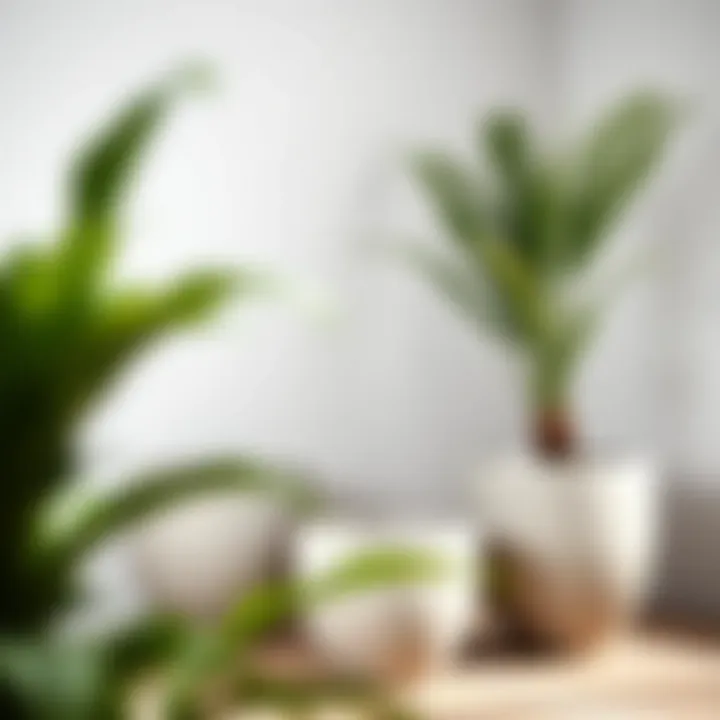
In contrast, minimalist approaches to design focus on simplicity and functionality. This concept emphasizes clean lines and an uncluttered look, making it attractive to contemporary homeowners. Minimalist concrete pots often feature muted colors and stark geometric shapes, which appeal to those who prefer a streamlined aesthetic.
The unique feature here could be the absence of excessive ornamentation, allowing the actual plants to take center stage. While this can sometimes come across as lacking character, many find that it encourages a fresh, modern feel in outdoor spaces.
Integration into Different Design Aesthetics
Modernist
Modernist designs utilize concrete pots as crucial focal points in landscaping. This style champions the concept of ‘form follows function’, meaning that aesthetics arise from the pot’s practicality. A key characteristic is the unconventional shapes that can break traditional boundaries, offering exciting possibilities for outdoor spaces.
These pots are not only beneficial for their striking appearances but also for their ability to serve various functions within a garden. However, the challenge is ensuring that the bold forms do not overwhelm the surrounding nature.
Rustic
The rustic style embraces natural textures, often featuring rough finishes that mimic handmade pottery. This look aims to evoke a sense of nostalgia and connection to nature. A key characteristic of rustic design is its emphasis on organic forms and earthy colors, reflecting a simpler lifestyle.
The unique feature here is that rustic concrete pots can appear as if they have weathered through time; this can significantly enhance their charm. Nonetheless, these rough textures might be more prone to collecting dirt and debris, which some might find less appealing.
Industrial
Industrial design presents a stark yet powerful aesthetic, utilizing raw materials and edgy style. Concrete pots in this realm often embrace a utilitarian vibe, showcasing imperfections and rough edges as a feature rather than a flaw. The advantage of industrial concrete pots is their ability to complement urban landscapes, making them a favourite among city dwellers.
The distinct and unmatched feature of this approach lies in the marriage of sophistication with ruggedness; hence, these pots work well in modern outdoor settings. However, their sometimes austere appearance can limit compatibility with more delicate or soft landscaping choices.
Understanding the cultural influences on concrete pot designs allows both designers and homeowners to select pieces that resonate personally while serving their functional roles in outdoor spaces.
For further insights into concrete pot designs and culture, visit wikipedia.com and reddit.com.
The Future of Outdoor Concrete Pots in Design
As we move forward into an era defined by innovation and sustainability, outdoor concrete pots are carving a unique niche in the broader design landscape. Their significance arises not simply from their aesthetic appeal but also from their potential to harmonize function with environmental consciousness. The future of these versatile containers will be shaped by innovative practices and technologies that enhance their functionality while aligning with contemporary design philosophies.
Innovative Trends
The trends shaping outdoor concrete pots are as dynamic as the materials themselves. Homeowners and designers alike are gravitating toward eco-friendly practices, seeking ways to integrate pot designs that not only showcase artistry but also emphasize sustainability.
One emerging trend is the use of recycled aggregates in the concrete mix, which not only lessens the carbon footprint but can also impart unique textures and colors to the pots. For instance, crushed glass or reclaimed concrete can be added to enhance visual interest, allowing for a variety of finishes—from polished to ruggedly textured—satisfying diverse aesthetic preferences.
Moreover, modular designs are gaining traction. This adaptability enables users to customize their outdoor spaces as needed. Unlike traditional pots, a modular system could allow for interlocking pieces that can grow or shrink in size or function, responding to seasonal changes, plant growth, or even changing design tastes. Rather than being confined to a single look, these pots can evolve, echoing the very nature of modern living.
- Textural Innovations: Innovative techniques, like the application of bio-based sealants, are paving the way for pots that also support plant health. These seals protect the interior of pots, ensuring plants thrive even in less than optimal conditions.
- Color Variability: New coloring agents allow for hues that resonate more with local landscapes or individual preferences without compromising durability. This kind of adaptability makes concrete pots not just containers but elements of personal expression in outdoor design.
Potential for Smart Technology Integration
Looking ahead, the integration of smart technology into outdoor concrete pots presents an exciting opportunity. As technology permeates every aspect of our lives, the desire for smart solutions in gardening and landscaping is becoming more prevalent. Imagine pots that can monitor soil moisture levels and temperature, sending alerts to your smartphone when plants need watering or care. These pots could even have built-in irrigation systems, gradually releasing water as needed, thereby optimizing plant health and reducing water waste.
Additionally, the use of sensors can track growth patterns and offer guidance on optimal sunlight exposure based on plant varieties. This means that not only do homeowners get to enjoy a beautiful garden, but they also engage with it intelligently.
Concrete pots optimized for smart technology offer numerous benefits:
- Resource Efficiency: By monitoring plant health, these pots can help in conserving water and nutrients, ultimately benefiting both plants and the environment.
- Integrated Aesthetics: Smart technology can be integrated without disrupting design coherence, maintaining the elegant simplicity that concrete pots are known for.
- Enhanced User Engagement: For DIYers and avid gardeners, the interactive elements add another layer of enjoyment to the gardening experience while providing substantial knowledge about plant care.
"The fusion of art and technology in concrete pot design promises not only to change the way we garden but also enhances our connection to nature in profound ways."
As the market becomes increasingly saturated with trends, understanding how outdoor concrete pots can evolve will greatly influence their reception among designers, homeowners, and retailers. In essence, as we step into the future, outdoor concrete pots may transform from mere plant containers to multifunctional, eco-aware elements of elegant design.
End
As we wrap up our deep dive into the versatility of outdoor concrete pots, it's clear that they have cemented their place in modern design. These robust containers are more than mere holders for plants; they serve as integral components of landscape architecture and interior aesthetics. The significance of outdoor concrete pots lies in their ability to blend functionality with artistic expression, capturing the imagination of homeowners, architects, and designers alike.
Reflecting on the Role of Concrete Pots in Design
Concrete pots not only house flora but also add a touch of character to any environment. Their solid structure provides an anchor in outdoor spaces, making them ideal for various styles, from minimalist gardens to lush, tropical escapes. Each pot serves as a canvas; whether it’s the sleek lines of a modern design or the rustic charm of a textured finish, they adapt beautifully to their surroundings. This adaptability not only enhances the visual appeal but also reinforces the connection between man-made structures and the natural world. The weight of concrete gives these pots a presence that often commands attention, symbolizing strength and stability.
Utilizing outdoor concrete pots strategically can significantly impact the flow of a space. When grouped thoughtfully or positioned to create focal points, they guide visitors through a landscape in a way that is both structured and nurturing to the ecosystem around them.
"Concrete pots can be the unsung heroes in garden design, marrying beauty with practicality."
Encouragement for Future Exploration
As we look to the future, the potential of outdoor concrete pots expands even further. Innovations in design and technology open the door to smart solutions that enhance sustainability and usability. Homeowners and designers should not shy away from experimenting with colors, finishes, and shapes.
This exploration can lead to unique garden designs that reflect individual tastes while expressing broader environmental values. With the promise of new coatings that improve weather resistance and the integration of sensors for monitoring moisture levels, concrete pots are poised to redefine gardening and landscaping.
Encouraging creativity in their use, outdoor concrete pots can transition seamlessly between public parks, private gardens, or even patios of urban homes. The journey doesn’t end here; it’s just beginning. So, get inspired, get planting, and let outdoor concrete pots revolutionize the way you interact with your space.



